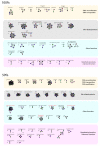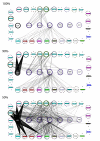Exploring the evolutionary dynamics of plasmids: the Acinetobacter pan-plasmidome
- PMID: 20181243
- PMCID: PMC2848654
- DOI: 10.1186/1471-2148-10-59
Exploring the evolutionary dynamics of plasmids: the Acinetobacter pan-plasmidome
Abstract
Background: Prokaryotic plasmids have a dual importance in the microbial world: first they have a great impact on the metabolic functions of the host cell, providing additional traits that can be accumulated in the cell without altering the gene content of the bacterial chromosome. Additionally and/or alternatively, from a genome perspective, plasmids can provide a basis for genomic rearrangements via homologous recombination and so they can facilitate the loss or acquisition of genes during these events, which eventually may lead to horizontal gene transfer (HGT). Given their importance for conferring adaptive traits to the host organisms, the interest in plasmid sequencing is growing and now many complete plasmid sequences are available online.
Results: By using the newly developed Blast2Network bioinformatic tool, a comparative analysis was performed on the plasmid and chromosome sequence data available for bacteria belonging to the genus Acinetobacter, an ubiquitous and clinically important group of gamma-proteobacteria. Data obtained showed that, although most of the plasmids lack mobilization and transfer functions, they have probably a long history of rearrangements with other plasmids and with chromosomes. Indeed, traces of transfers between different species can be disclosed.
Conclusions: We show that, by combining plasmid and chromosome similarity, identity based, network analysis, an evolutionary scenario can be described even for highly mobile genetic elements that lack extensively shared genes. In particular we found that transposases and selective pressure for mercury resistance seem to have played a pivotal role in plasmid evolution in Acinetobacter genomes sequenced so far.
Figures




Similar articles
-
Plasmids Shaped the Recent Emergence of the Major Nosocomial Pathogen Enterococcus faecium.mBio. 2020 Feb 11;11(1):e03284-19. doi: 10.1128/mBio.03284-19. mBio. 2020. PMID: 32047136 Free PMC article.
-
What do we know about plasmids carried by members of the Acinetobacter genus?World J Microbiol Biotechnol. 2020 Jul 13;36(8):109. doi: 10.1007/s11274-020-02890-7. World J Microbiol Biotechnol. 2020. PMID: 32656745 Review.
-
Origin and Evolution of Rickettsial Plasmids.PLoS One. 2016 Feb 11;11(2):e0147492. doi: 10.1371/journal.pone.0147492. eCollection 2016. PLoS One. 2016. PMID: 26866478 Free PMC article.
-
Plasmidome of an environmental Acinetobacter lwoffii strain originating from a former gold and arsenic mine.Plasmid. 2020 Jul;110:102505. doi: 10.1016/j.plasmid.2020.102505. Epub 2020 May 4. Plasmid. 2020. PMID: 32380021
-
Genome evolution within the alpha Proteobacteria: why do some bacteria not possess plasmids and others exhibit more than one different chromosome?FEMS Microbiol Rev. 1998 Oct;22(4):255-75. doi: 10.1111/j.1574-6976.1998.tb00370.x. FEMS Microbiol Rev. 1998. PMID: 9862123 Review.
Cited by
-
PlasFlow: predicting plasmid sequences in metagenomic data using genome signatures.Nucleic Acids Res. 2018 Apr 6;46(6):e35. doi: 10.1093/nar/gkx1321. Nucleic Acids Res. 2018. PMID: 29346586 Free PMC article.
-
The genomic diversification of the whole Acinetobacter genus: origins, mechanisms, and consequences.Genome Biol Evol. 2014 Oct 13;6(10):2866-82. doi: 10.1093/gbe/evu225. Genome Biol Evol. 2014. PMID: 25313016 Free PMC article.
-
A global survey of Salmonella plasmids and their associations with antimicrobial resistance.Microb Genom. 2023 May;9(5):mgen001002. doi: 10.1099/mgen.0.001002. Microb Genom. 2023. PMID: 37200081 Free PMC article.
-
Structure and Evolution of Acinetobacter baumannii Plasmids.Front Microbiol. 2020 Jun 18;11:1283. doi: 10.3389/fmicb.2020.01283. eCollection 2020. Front Microbiol. 2020. PMID: 32625185 Free PMC article.
-
DNA uptake by the nosocomial pathogen Acinetobacter baumannii occurs during movement along wet surfaces.J Bacteriol. 2013 Sep;195(18):4146-53. doi: 10.1128/JB.00754-13. Epub 2013 Jul 12. J Bacteriol. 2013. PMID: 23852865 Free PMC article.
References
-
- Medini D, Donati C, Tettelin H, Masignani V, Rappuoli R. The microbial pan-genome. Current opinion in genetics & development. 2005;15(6):589–594. - PubMed
MeSH terms
Substances
LinkOut - more resources
Full Text Sources
Other Literature Sources

